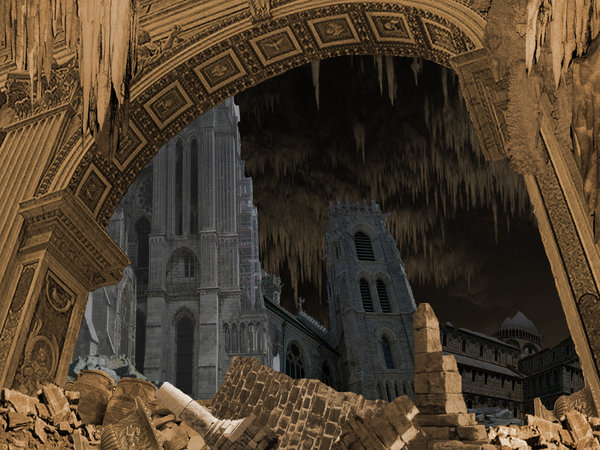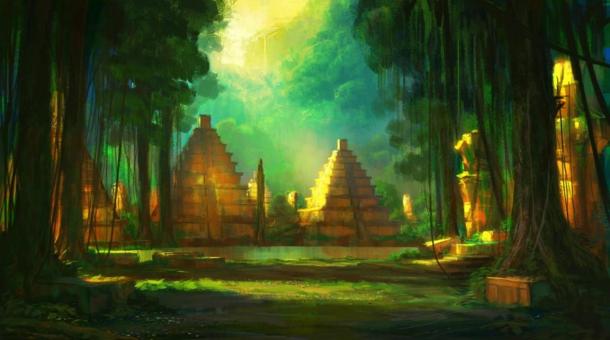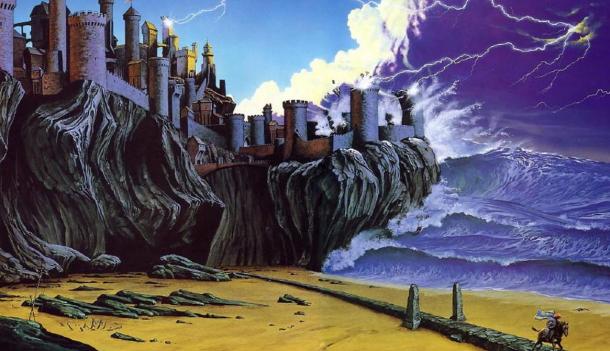Five Legendary Lost Cities...
- Details
- Written by AndEl

...That Have Never Been Found
The story of Atlantis is one of the most renowned and enduring tales of a lost city, said to have been swallowed up by the sea and lost forever. Yet, the story of Atlantis is not unique, as other cultures have similar legends of landmasses and cities that have disappeared under the waves, been lost beneath desert sands, or buried beneath centuries of vegetation. From the ancient homeland of the Aztecs, to jungle cities of gold and riches, we examine five legendary lost cities that have never been found.
Percy Fawcett and the Lost City of Z

Since Europeans first arrived in the New World, there have been stories of a legendary jungle city of gold, sometimes referred to as El Dorado. Spanish Conquistador, Francisco de Orellana was the first to venture along the Rio Negro in search of this fabled city. In 1925, at the age of 58, explorer Percy Fawcett headed into the jungles of Brazil to find a mysterious lost city he called “Z”. He and his team would vanish without a trace and the story would turn out be one of the biggest news stories of his day. Despite countless rescue missions, Fawcett was never found.
In 1906, the Royal Geographical Society, a British organization that sponsors scientific expeditions, invited Fawcett to survey part of the frontier between Brazil and Bolivia. He spent 18 months in the Mato Grosso area and it was during his various expeditions that Fawcett became obsessed with the idea of lost civilizations in this area. In 1920, Fawcett came across a document in the National Library of Rio De Janeiro called Manuscript 512. It was written by a Portuguese explorer in 1753, who claimed to have found a walled city deep in the Mato Grosso region of the Amazon rainforest, reminiscent of ancient Greece. The manuscript described a lost, silver laden city with multi-storied buildings, soaring stone arches, wide streets leading down towards a lake on which the explorer had seen two white Indians in a canoe. Fawcett called this the Lost City of Z.
In 1921, Fawcett set out on his first of many expeditions to find the Lost City of Z, but his team were frequently hindered by the hardships of the jungle, dangerous animals, and rampant diseases. Percy’s final search for Z culminated in his complete disappearance. In April 1925, he attempted one last time to find Z, this time better equipped and better financed by newspapers and societies including the Royal Geographic Society and the Rockefellers. In his final letter home, sent back via a team member, Fawcett sent a message to his wife Nina and proclaimed “We hope to get through this region in a few days.... You need have no fear of any failure.” It was to be the last anyone would ever hear from them again.
While Fawcett’s lost city of Z has never been found, numerous ancient cities and remains of religious sites have been uncovered in recent years in the jungles of Guatemala, Brazil, Bolivia and Honduras. With the advent of new scanning technology, it is possible that an ancient city that spurred the legends of Z, may one day be found.
The Lost City of Aztlan – Legendary Homeland of the Aztecs

The Aztec people of Mexico created one of the most powerful empires of the ancient Americas. While much is known about their empire located where today’s Mexico City can be found, less is known about the very start of the Aztec culture. Many consider the missing island of Aztlan to be the ancient homeland where the Aztec people began to form as a civilization prior to their migration to the Valley of Mexico. Some believe it is a mythical land, similar to Atlantis or Camelot, which will live on through legend but will never be found in physical existence. Others believe it to be a true, physical location that will someday be identified. Searches for the land of Aztlan have spanned from Western Mexico, all the way to the deserts of Utah, in hopes of finding the legendary island. However, these searches have been fruitless, as the location – and existence – of Aztlan remain a mystery.
The formation of civilization at Aztlan comes from legend. According to Nahuatl legend, there were seven tribes that once lived at Chicomoztoc – “the place of the seven caves.” These tribes represented the seven Nahua groups: Acolhua, Chalca, Mexica, Tepaneca, Tlahuica, Tlaxcalan, and Xochimilca (different sources provide variations on the names of the seven groups). The seven groups, being of similar linguistic groups, left their respective caves and settled as one group near Aztlan.
The word Aztlan means “the land to the north; the land from whence we, the Aztecs, came.” It is said that eventually, the people who inhabited Aztlan became known as the Aztecs, who then migrated from Aztlan to the Valley of Mexico. The Aztec migration from Aztlan to Tenochtitlán is a very important piece of Aztec history. It began on May 24, 1064, which was the first Aztec solar year.
To this day, the actual existence of an island known as Aztlan has not been confirmed. Many have searched for the land, in hopes of having a better understanding of where the Aztecs came from, and perhaps a better understanding of ancient Mexican history. However, like other lost cities, it is not clear whether Aztlan will ever be found.
The Lost Land of Lyonesse – Legendary City on the Bottom of the Sea

In Arthurian legend, Lyonesse is the home country of Tristan, from the legendary story of Tristan and Iseult. The mythical land of Lyonesse is now referred to as the “Lost Land of Lyonesse,” as it is ultimately said to have sunk into the sea. However, the legendary tale of Tristan and Iseult shows that Lyonesse is known for more than sinking into the ocean, and that it had a legendary presence while it remained above ground. While Lyonesse is mostly referred to in stories of legend and myth, there is some belief that it represents a very real city that sunk into the sea many years ago. With such a legendary location, it can be difficult to ascertain where the legend ends and reality begins.
There are some variations in the legends that surround the sinking of the land. Prior to its sinking, Lyonesse would have been quite large, containing one hundred and forty villages and churches. Lyonesse is said to have disappeared on November 11, 1099 (although some tales use the year 1089, and some date back to the 6th century). Very suddenly the land was flooded by the sea. Entire villages were swallowed, and the people and animals of the area drowned. Once it was covered in water, the land never reemerged. While the Arthurian tales are legendary, there is some belief that Lyonesse was once a very real place attached to the Scilly Isles in Cornwall, England. Evidence shows that sea levels were considerably lower in the past, so it is very possible that an area that once contained a human settlement above-ground is now beneath the sea level. Indeed, fisherman near the Scilly Isles tell tales of retrieving pieces of buildings and other structures from their fishing nets. These stories have never been substantiated, and are viewed by some as tall tales.
From the legendary tales of Tristan and Iseult, to Arthur’s final battle with Mordred, to the stories of a city being swallowed by the sea, the tales of Lyonesse invoke a vast array of thoughts and emotions by those who wish to know more about this legendary city, and who like to believe that it’s legendary tales are founded upon a very real lost city.
The Search for El Dorado – Lost City of Gold

For hundreds of years, treasure hunters and historians alike have searched for El Dorado, the lost city of gold. The idea of a city filled with gold and other riches has a natural appeal, drawing the attention of individuals from all over the world in hopes of discovering the ultimate treasure, and an ancient wonder. In spite of numerous expeditions around all of Latin America, the city of gold remains a legend, with no physical evidence to substantiate its existence.
The origins of El Dorado come from legendary tales of the Muisca tribe. Following two migrations – one in 1270 BC and one between 800 and 500 BC, the Muisca tribe occupied the Cundinamarca and Boyacá areas of Colombia. According to legend, as written in Juan Rodriguez Freyle’s “El Carnero,” the Muisca practiced a ritual for every newly appointed king that involved gold dust and other precious treasures.
When a new leader was appointed, many rituals would take place before he took his role as king. During one of these rituals, the new king would be brought to Lake Guatavita, where he would be stripped naked, and covered in gold dust. He would be placed upon a highly decorated raft, along with his attendants, and piles of gold and precious stones. The raft would be sent out to the center of the lake, where the king would wash the gold dust from his body, as his attendants would throw the pieces of gold and precious stones into the lake. This ritual was intended as a sacrifice to the Muisca's god. To the Muisca, “El Dorado” was not a city, but the king at the center of this ritual, also called “the Gilded One.” While El Dorado is meant to refer to the Gilded One, the name has now become synonymous with the lost city of gold, and any other place where one can quickly obtain wealth.
In 1545, Conquistadores Lázaro Fonte and Hernán Perez de Quesada attempted to drain Lake Guatavita. As they did so, they found gold along its shores, fueling their suspicion that the lake contained a treasure of riches. They worked for three months, with workers forming a bucket chain, but they were unable to drain the lake sufficiently to reach any treasures deep within the lake. In 1580, another attempt to drain the lake was made by business entrepreneur Antonio de Sepúlveda. Once again, various pieces of gold were found along the shores, but the treasure at the depths of the lake remained concealed. Other searches were conducted on Lake Guatavita, with estimates that the lake could contain up to $300 million in gold, with no luck in finding the treasures. All searches came to a halt when the Colombian government declared the lake a protected area in 1965. Nonetheless, the search for El Dorado continues, even without the ability to search Lake Guatavita. The legends of the Muisca tribe, the Gilded One and their ritualistic sacrifice of treasures have transformed over time into today’s tale of El Dorado, lost city of gold.
The Lost Desert Cities of Dubai: The Hidden History

Dubai cultivates an ultra-modern image of dazzling architecture and effortless wealth. Yet its deserts conceal forgotten cities and a hidden history which reveal how its early inhabitants adapted and overcame dramatic past climate change.
One of the most famous lost cities of Arabia – tantalizingly so because historians have known it existed from written records but simply could not find it – is the medieval city of Julfar. Home to the legendary Arabian seafarer Ahmed ibn Majid, as well as allegedly to the fictional Sindbad the Sailor, Julfar thrived for a thousand years before falling into ruin and disappearing from human memory for almost two centuries. Unlike other desert cities, Julfar was a thriving port, in fact the hub of southern Gulf Arabic trade in the Middle Ages.
Julfar was known to be somewhere on the Persian Gulf coast north of Dubai, but the actual site was only found by archaeologists in the 1960s. The earliest signs of settlement found on the site date from the 6th century, by which time its inhabitants were already trading as far afield as India and the Far East on a routine basis.
The 10th to 14th centuries were a golden age for Julfar and for long-distance Arab trading and seafaring, with Arab navigators routinely traveling halfway around the world. Arabs had sailed into European waters long before Europeans succeeded in navigating through the Indian Ocean and into the Persian Gulf, for instance. As the main base for these voyages and trade, Julfar was the largest and most important city in the southern Gulf for over a thousand years. Arab merchants routinely made the mammoth eighteen-month sea voyage as far as China, and traded almost everything imaginable.
Such a valuable commercial centre attracted constant attention from rival powers though. The Portuguese took control in the 16th century, by which time Julfar was a substantial city of around 70,000 people. A century later the Persians seized it, only to lose it in 1750 to the Qawasim tribe from Sharjah who established themselves next-door at Ras al-Khaimah, which they continue to rule to this day, leaving the old Julfar to gradually decay until its ruins became forgotten amongst the coastal sand dunes. Today most of Julfar in all likelihood remains still hidden beneath the sprawling dunes north of Ras al-Khaimah.” – courtesy David Millar
Liked this article? Dive deeper into personal growth and wellness! Check out CrystalWind.ca for spiritual wisdom or explore AromaWorx.ca for natural well-being tips. Spread the positivity—share this with friends on their happiness journey!
Let’s Chat! Drop Your Thoughts Below! ![]()
Latest Articles

Imagine a world of inspiration and healing, free for all—made possible by YOU!
Donate Now—Ignite the Magic at CrystalWind.ca!

Epilepsy - Finding A Cure
Your donation can make a difference!
Help us find a cure – donate now!
Unlock Your Light: Join Lightworkers Worldwide on CrystalWind.ca!
Articles: Atlantis
Articles: Crop Circles
Articles: Lemuria
Articles: Hollow Earth
Articles: Power Places
Articles: Sacred Places
Follow Us!
Featured This Month
Sweet Violet
Sweet Violet Faithfulness and modesty. “I will always be true to you.” Helps... Read more
Mabon Magic: Ideas For Fall Decoration And R…
Welcome (almost!) to Fall! We’re turning the Great Wheel once again, toward ... Read more
Mabon in Modern Times: Fresh Takes on the Au…
The Mabon season begins somewhere around the 21st-22nd of September and cont... Read more
Peridot: The Healer's Stone
Peridot has been used as a Power Stone for centuries. Peridot fosters emotio... Read more
Virgo Mythology
The Virgo Myth In all of constellation mythology, few legends are as misund... Read more
The Vine: September 2nd - September 29th
The Autumnal Equinox ( Alban Elfed ) Celtic Symbol : The White Swan Read more
Watermelon Tourmaline
Synonym: Rainbow Tourmaline The watermelon tourmaline is a rare variety t... Read more
Sun in Virgo
An Overview of Sun Sign Characteristics for Virgo Virgo is guided by Mercur... Read more
Crystals for Virgo
As the warmth of summer begins to soften into the crispness of autumn, the Sun... Read more












































